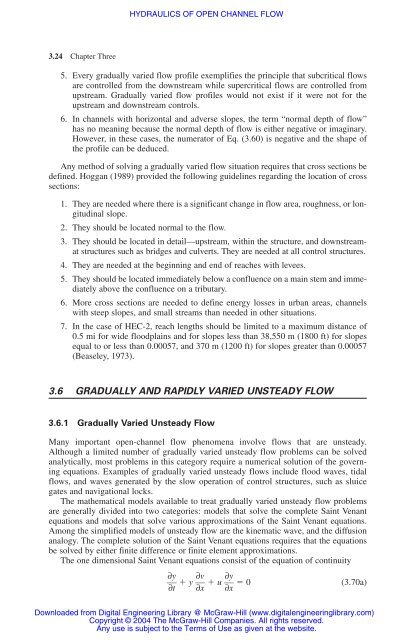chapter 3 hydraulics of open channel flow
chapter 3 hydraulics of open channel flow
chapter 3 hydraulics of open channel flow
You also want an ePaper? Increase the reach of your titles
YUMPU automatically turns print PDFs into web optimized ePapers that Google loves.
3.24 Chapter Three<br />
HYDRAULICS OF OPEN CHANNEL FLOW<br />
5. Every gradually varied <strong>flow</strong> pr<strong>of</strong>ile exemplifies the principle that subcritical <strong>flow</strong>s<br />
are controlled from the downstream while supercritical <strong>flow</strong>s are controlled from<br />
upstream. Gradually varied <strong>flow</strong> pr<strong>of</strong>iles would not exist if it were not for the<br />
upstream and downstream controls.<br />
6. In <strong>channel</strong>s with horizontal and adverse slopes, the term “normal depth <strong>of</strong> <strong>flow</strong>”<br />
has no meaning because the normal depth <strong>of</strong> <strong>flow</strong> is either negative or imaginary.<br />
However, in these cases, the numerator <strong>of</strong> Eq. (3.60) is negative and the shape <strong>of</strong><br />
the pr<strong>of</strong>ile can be deduced.<br />
Any method <strong>of</strong> solving a gradually varied <strong>flow</strong> situation requires that cross sections be<br />
defined. Hoggan (1989) provided the following guidelines regarding the location <strong>of</strong> cross<br />
sections:<br />
1. They are needed where there is a significant change in <strong>flow</strong> area, roughness, or longitudinal<br />
slope.<br />
2. They should be located normal to the <strong>flow</strong>.<br />
3. They should be located in detail—upstream, within the structure, and downstreamat<br />
structures such as bridges and culverts. They are needed at all control structures.<br />
4. They are needed at the beginning and end <strong>of</strong> reaches with levees.<br />
5. They should be located immediately below a confluence on a main stem and immediately<br />
above the confluence on a tributary.<br />
6. More cross sections are needed to define energy losses in urban areas, <strong>channel</strong>s<br />
with steep slopes, and small streams than needed in other situations.<br />
7. In the case <strong>of</strong> HEC-2, reach lengths should be limited to a maximum distance <strong>of</strong><br />
0.5 mi for wide floodplains and for slopes less than 38,550 m (1800 ft) for slopes<br />
equal to or less than 0.00057, and 370 m (1200 ft) for slopes greater than 0.00057<br />
(Beaseley, 1973).<br />
3.6 GRADUALLY AND RAPIDLY VARIED UNSTEADY FLOW<br />
3.6.1 Gradually Varied Unsteady Flow<br />
Many important <strong>open</strong>-<strong>channel</strong> <strong>flow</strong> phenomena involve <strong>flow</strong>s that are unsteady.<br />
Although a limited number <strong>of</strong> gradually varied unsteady <strong>flow</strong> problems can be solved<br />
analytically, most problems in this category require a numerical solution <strong>of</strong> the governing<br />
equations. Examples <strong>of</strong> gradually varied unsteady <strong>flow</strong>s include flood waves, tidal<br />
<strong>flow</strong>s, and waves generated by the slow operation <strong>of</strong> control structures, such as sluice<br />
gates and navigational locks.<br />
The mathematical models available to treat gradually varied unsteady <strong>flow</strong> problems<br />
are generally divided into two categories: models that solve the complete Saint Venant<br />
equations and models that solve various approximations <strong>of</strong> the Saint Venant equations.<br />
Among the simplified models <strong>of</strong> unsteady <strong>flow</strong> are the kinematic wave, and the diffusion<br />
analogy. The complete solution <strong>of</strong> the Saint Venant equations requires that the equations<br />
be solved by either finite difference or finite element approximations.<br />
The one dimensional Saint Venant equations consist <strong>of</strong> the equation <strong>of</strong> continuity<br />
� ∂y<br />
� � y �<br />
∂t<br />
∂v<br />
� � u �<br />
∂x<br />
∂y<br />
� � 0 (3.70a)<br />
∂x<br />
Downloaded from Digital Engineering Library @ McGraw-Hill (www.digitalengineeringlibrary.com)<br />
Copyright © 2004 The McGraw-Hill Companies. All rights reserved.<br />
Any use is subject to the Terms <strong>of</strong> Use as given at the website.

















